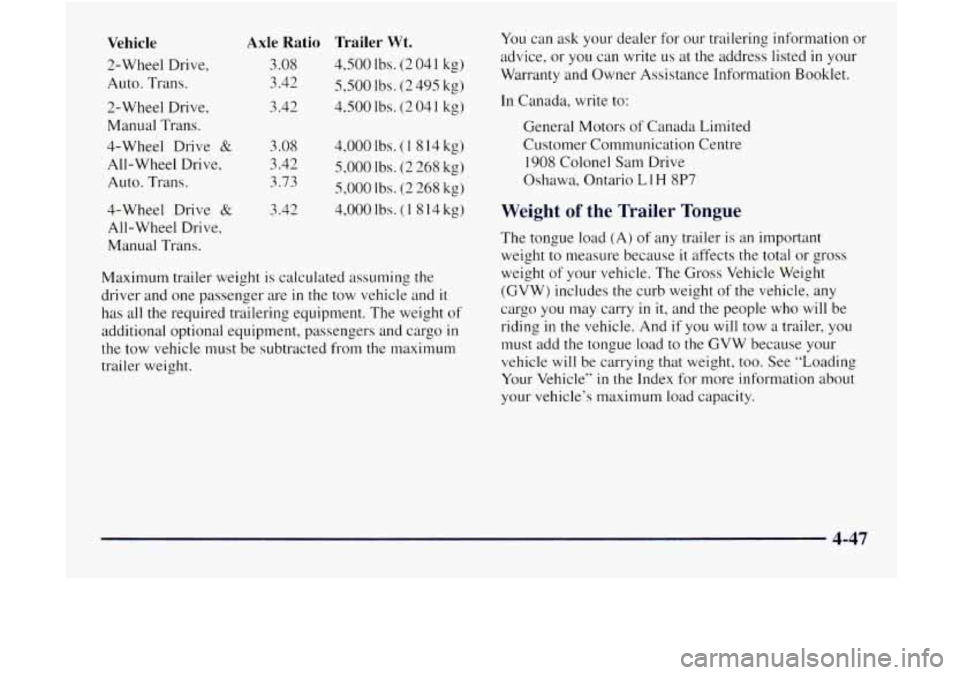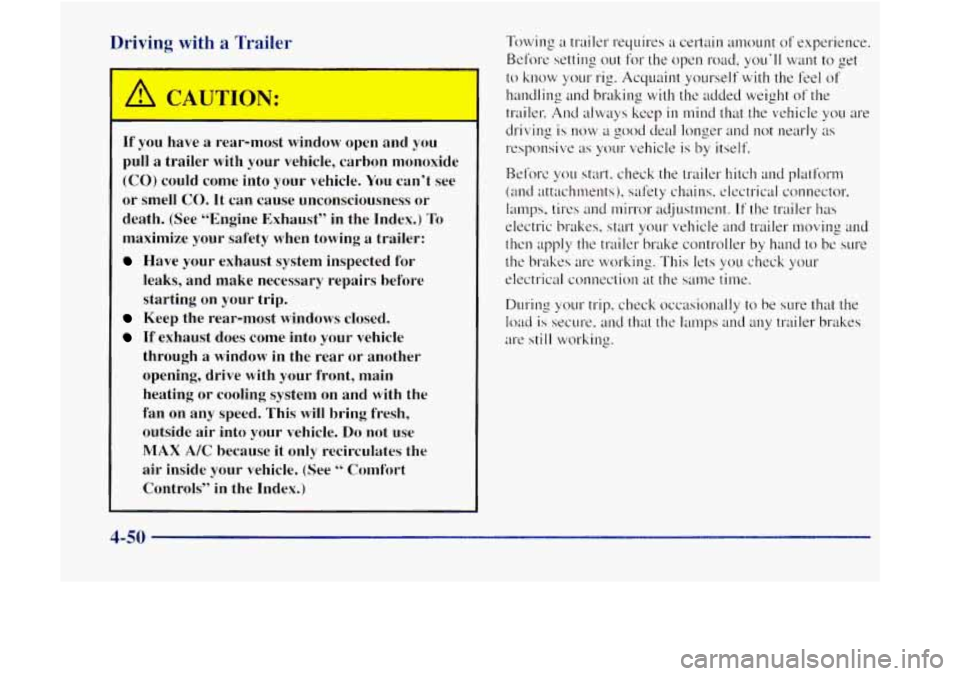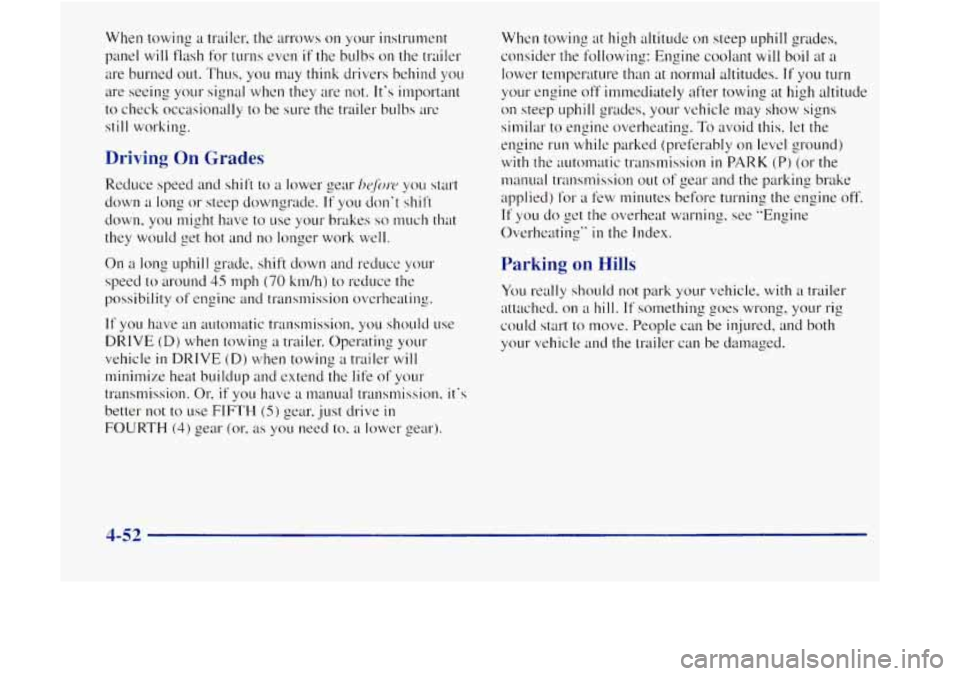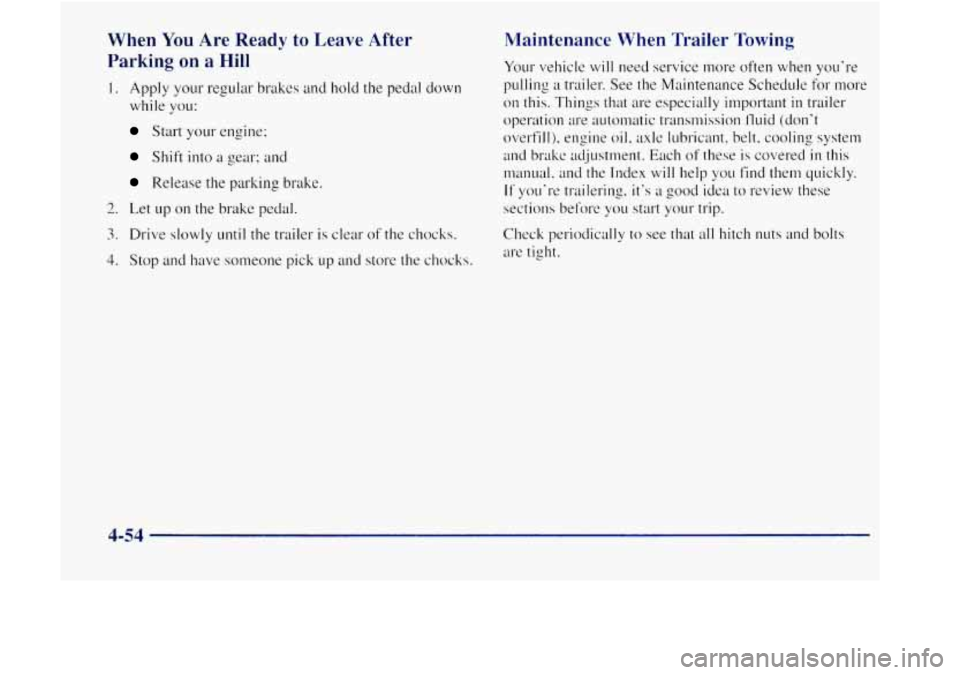GMC JIMMY 1997 Owner's Manual
Manufacturer: GMC, Model Year: 1997, Model line: JIMMY, Model: GMC JIMMY 1997Pages: 410, PDF Size: 20.03 MB
Page 211 of 410

If You Do Decide To Pull A Trailer
If you do, here are some important points:
0
0
0
0
There are many different laws, including speed limit
restrictions, having to do with trailering. Make sure
your rig
will be legal, not only where you live but
also where you’ll be driving.
A good source for this
information can be state or provincial police.
Consider using a sway control
if your trailer will
weigh
2,000 lbs. (900 kg) or less. You should always
use a sway control
if your trailer will weigh more
than
2,000 lbs. (900 kg). You can ask a hitch dealer
about sway controls.
Don’t tow a trailer at all during the first
500 miles
(800 km) your new vehicle is driven. Your engine,
axle or other parts could be damaged.
Then, during the first
500 miles (800 km) that you
tow a trailer, don’t drive over
50 mph (80 km/h) and
don’t nuke starts at
full throttle. This helps your
engine and other parts
of your vehicle wear in at the
heavier loads.
If you have an automatic transmission, you can use
DRIVE
(D) (or, as you need to, a lower gear) when
towing
a trailer. Operating your vehicle in
DRIVE (D) when towing a trailer will minimize heat
buildup and extend the life
of your transmission. If
you have a manual transmission and you are towing
a trailer, it‘s better not to use FIFTH (5) gear. Just
drive
in FOURTH (4) gear (or, as you need to, a
lower gear).
Three important considerations have to do
with weight:
the weight of the trailer,
0 the weight of the trailer tongue
and the weight on your vehicle’s tires.
Weight of the Trailer
How heavy can a trailer safely be?
It depends on how you plan to use your rig. For
example, speed, altitude, road grades, outside
temperature and how much your vehicle
is used to pull a
trailer are all important. And,
it can also depend on any
special equipment that you have on your vehicle.
The following chart shows how much your trailer can
weigh, based upon your vehicle model and options.
4-46
Page 212 of 410

Vehicle
2-Wheel Drive,
Auto. Trans.
2- Wheel Drive,
Manual Trans.
4-Wheel Drive
&
All-Wheel Drive. Auto. Trans.
4-Wheel Drive
&
All-Wheel Drive,
Manual Trans.
Axle Ratio Trailer Wt.
3.08 4,500 lbs. (2 04 1 kg)
3.42 5,500 lbs. (2 495 kg)
3.42 4,500 Ibs. (2 04
1 kg)
3.08
3.42
3.73
3.42 4,000
lbs.
(1 8 14 kg)
5,000 Ibs. (2 268 kg)
5,000 Ibs.
(2 268 kg)
4,000 lbs.
( 1 8 14 kg)
Maximum trailer weight is calculated assuming the
driver and one passenger are
in the tow vehicle and it
has all the required trailering equipment. The weight of
additional optional equipment, passengers and cargo
in
the tow vehicle must be subtracted from the maximum
trailer weight. You
can ask your dealer for our trailering information or
advice, or you can write us at the address listed
in your
Warranty and Owner Assistance Information Booklet.
In Canada, write to:
General Motors of Canada Limited
Customer Communication Centre
1908 Colonel Sam Drive
Oshawa, Ontario
LI H 8P7
Weight of the Trailer Tongue
The tongue load (A) of any trailer is an important
weight to measure because
it affects the total or gross
weight of your vehicle. The Gross Vehicle Weight
(GVW) includes the curb weight of the vehicle, any
cargo you may carry
in it, and the people who will be
riding
in the vehicle. And if you will tow a trailer, you
must add the tongue load to the GVW because your
vehicle
will be carrying that weight, too. See ”Loading
Your Vehicle”
in the Index for more information about
your vehicle’s maximum load capacity.
4-47
Page 213 of 410

A B
If you're using a weight-carrying hitch, the trailer
tongue
(A) should weigh 10 percent of the total loaded
trailer weight
(B). If you're using a weight-distributill~
hitch, the trailer tongue
(A) should weigh I2 percent of
the total loaded trailer weight (B).
After you've loaded your trailer, weigh the trailer and
then the tongue, separately, to see
if the weights are
proper.
If they aren't, you may be able to get them right
simply by moving some. items around in the trailer.
Total Weight on Your Vehicle's Tires
Be sure your vehicle's tires are inflated to the upper
limit for cold tires. You'll find these numbers on the
Cel-tification/Tire
label on the driver's door edge, above
the door latch,
or see "Tire Loading" in the Index. Then
be
SL~ you don't go over the GVW limit for your
vehicle, including the weight
of the trailer tongue.
Hitches
It's important to have the correct hitch equipment.
Crosswinds. large trucks going
by and rough roads are a
few reasons why you'll need the right hitch. Here are
some rules to follow:
0 If' YOLI'II be pulling a trailer that, when loaded, will
weigh more than
2,000 lbs. (900 kg), be sure to LW a
properly mounted, weight-distributing hitch and
sway control of the proper size. This equipment is
very important for proper vehicle loading and good
handling when you're driving.
4-48
Page 214 of 410

Will you have to make any holes in the body of your
vehicle when you install
ti trailer hitch'?
If you do. then be sure to seal the holes later when
you remove the hitch.
If you don't seal them, deadly
carbon monoxide
(CO) f~-om your exhaust can get
into your vehicle (see "Carbon Monoxide"
in the
Index).
Dirt and water can, too.
Safety Chains
you should always attach chains between yo11r vehicle
and
your trailer. Cross the safety chains under the tongue
of the trailer so that the tongue will not drop to the road
if it becomes separated from the hitch. Instructions
about safety chains may be provided by the hitch
manufilcturer
or by the trailer manufacturer. Follow the
manufacturer's recommendation for attaching safety
chains and
clo not attach them to the blmper. Always
leavejust enough slack
so you can turn with your rig.
And, never
allow safety chains to drag on the ground.
Trailer Brakes
If your trailer weighs more than 1.000 Ibs. (450 kg)
loaded, then it needs its own brakes -- and they must be
adequate. Be sure to read and follow the instructions
for
the trailer brakes so you'll be able to install, adjust and
n1aintain them properly.
Your trailer*s
brake system can tap into the vehicle's
hydraulic
brake system only if:
The trailer parts can withstand 3.000 psi
(20 650 kPa) of pressure.
0 The traileras brake system will use less th;m
0.02 cubic inch (0.3 cc) of fluid from your vehicle's
master cylinder-. Otherwise. both braking systems
won't work well.
You could even lose your brakes.
If everything checks out this far, then make the brake
tluid tap at the port on the master cylinder that sends
fluid to the
ear brakes. But don't use copper tubing for
this. If you do, it will bend and finally break off. Use
steel brake tubing.
4-49
Page 215 of 410

Driving with a Trailer
1 CAUTION:
If you have a rear-most window open and you
pull a trailer with your vehicle, carbon nlonoxide
(CO) could corne into your vehicle. You can’t see
or smell CO. It can cause unconsciousness or
death. (See “Engine Exhaust” in the Index.)
To
maximize your safety when towing a trailer:
Have your exhaust system inspected for
leaks, and make necessary repairs before
starting
on your trip.
Keep the rear-most windows closed.
If exhaust does come into your vehicle
through a window in the rear or another
opening, drive with your front, main
heating
or cooling system on and with the
fan on any speed.
This will bring fresh,
outside air into your vehicle. Do not use
MAX AX because it only recirculates the
air inside your vehicle. (See “ Comfort
Controls” in the Index.)
4-50
Page 216 of 410

Following Distance
Backing
Up
Making Turns
NOTICE:
Making very sharp turns while trailering could
cause the trailer to come
in contact with the
vehicle.
Your vehicle could be damaged. Avoid
making very sharp turns while trailering.
Turn Signals When Towing a Trailer
4-51
Page 217 of 410

When towing a trailer, the ~~rrows on your instrument
panel
will flash for turns even if the bulbs on the trailer
itre burned out. Thus. you may think drivers behind you
are seeing your signal when they are not. It's important
to check occasionally to be sure the trailer bulbs arc
still working.
Driving On Grades
On a long uphill grade, shift down and reducc your
speed
to around 45 mph (70 km/h) to reduce the
possibility
of engine and transmission ovc.rheating.
If you have an automatic transmission. you should use
DRIVE
(D) when towing a trailer. Operating your
vehicle
in DRIVE (D) when towing a trailer will
minimize heat buildup and extend the life
of your
trrmsmission. Or:
if you have ;1 manual transmission. it's
better not to use FIFTH (5) gear. just drive in
FOURTH (4) gear (or, as you need to, a I~MW gear). Whcn
towins at high altitude
on steep uphill grades,
consider the following: Engine coolant will boil at a
lower temperature than at normal altitudes. If yo^^ turn
your engine off immediately after towing
at high altitude
on steep uphill grades, your \:ellicle may show signs
similar to engine overheating.
To avoid this. let the
engine
r~~n while parked (preferably on level grout1d)
with the automatic transmission in PARK (Pj (or the
1manuaI transmission out of
gear and the parking brake
applied) 1'01-
;I few minutes before turning the engine off.
If you do get the overheat warning. see "Engine
Overheating"
in the Index.
Parking on Hills
You really should not park your vehicle. with a trailer
attached.
on a hill. If something goes wrong, your rig
could start
to move. People can be injured, and both
yo~~r vehicle and the trailer can
be damaged.
4-52
Page 218 of 410

1.
L. 7
3.
4.
5.
6.
Apply your regultu- brakes, but don‘t shift into
PARK (P) yet. or into gear for a nxmual
transmission. Then
t111-n your wheels into the curb if
facing downhill or into traffic if facing uphill.
Have someone place chocks under the trailer wheels.
When the wheel chocks are in place, release the
regular
brakes until the chocks absorb the load.
Reapply the reglrlar brakes. Then apply your parking
brake,
and then shift into PARK (P). or
REVERSE (R) for a manual transmission.
If yo^^ have ;t I’our-~yheel-dl-ive \:ellick with a
manual transfer case shift lever, be SLIR the transfer
case
is in a drive gear -- not in NEUTRAL (N).
Release the regular brakes. It can
be dangerous to get out of your vehicle
if
the shift lever is not fully in PARK (P) with the
parking brake firmly set. Your vehicle can
roll.
If you have left the engine running, the vehicle
can move suddenly. You
01- others could be
injured.
‘li) be sure your vehicle won’t n~ove, even
when you’re
on fairly level ground, use the steps
that follow.
If you have four-wheel drive with
a nlanual
transfer case shift lever and your transfer case
is
in NEUTRAL (N), your vehicle will he free to
roll, even
if your shift lever is in PARK (P). So, be
sure the transfer case is in a drive gear
-- not in
NEUTRAL (N).
4-53
Page 219 of 410

When You Are Ready to Leave After
Parking on
a Hill
I, Apply your reg~~lar brakes and lwld the pedal down
while you:
Start your engine;
Shift into a gear: and
Release the parking brake.
2. Let up on the brake pedal.
3. Drive slowly until the trailer is clear of the chocks.
4. Stop and have someone pick up and store the chocks.
Maintenance When Trailer Towing
Your vehicle will need service nlore often when you're
pulling a trailer. See the Maintenance Schedule for more
on
this. Things that are especially important in trailer
operation
are automatic transmission fluid (don't
overfill), engine
oil. ~~xle lubricant, belt, cooling system
and
brakc adjustment. Each of these is covered in this
manurd.
and the Index will help you find then] quickly.
If you're trailering. it's a good idea to review these
sections before you start your trip.
Check periodically
to see that all hitch nuts and bolts
are tight.
4-54
Page 220 of 410

Trailer Wiring Harness
0 White (Heavy Gage): Ground wire.
4-55